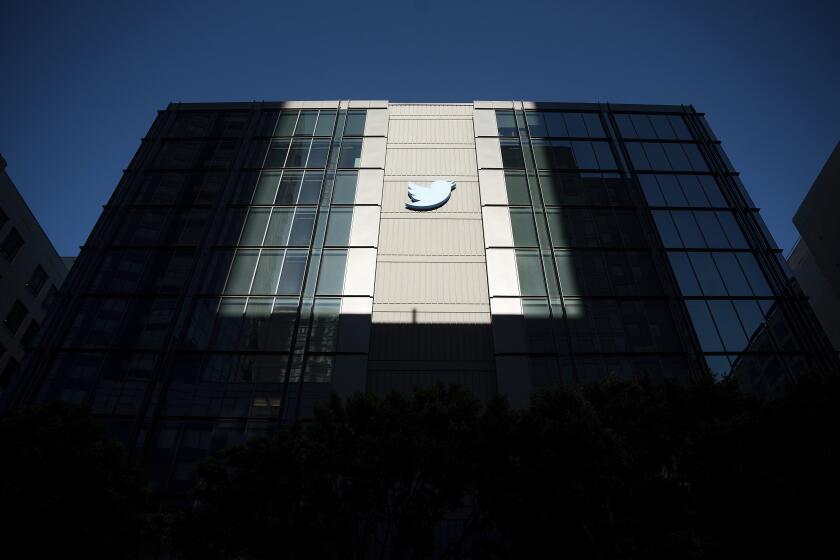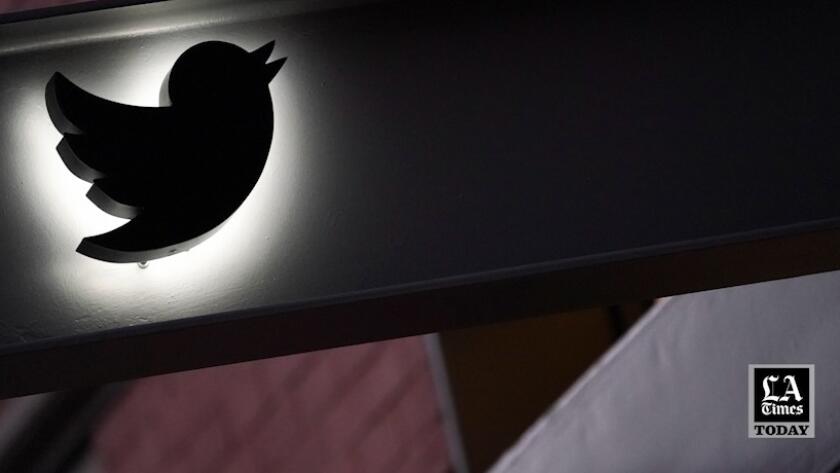Thinking of quitting Twitter? Here’s everything you should know

- Share via
If you are reading this, you’re probably despairing over your Twitter feed.
Since Elon Musk became the owner of Twitter in late October, the company has been in chaos. Twitter laid off half its employees. Key executives were fired or quit. Advertisers pulled back, and federal regulators are hovering. Meanwhile, to test the new owner, extremists have spewed racist slurs and Nazi memes and celebrity and corporate impersonator accounts have proliferated.
Some users have exited the platform over a variety of final straws, tweeting grim goodbye notes and directing their followers to alternative social media platforms where they can be reached. Others have said they will continue tweeting until the platform is obsolete. (Musk tweeted Sunday that user numbers have “increased significantly” since the acquisition was announced.)
Here is a guide to what to consider when making a decision on whether to leave the platform, and some potential alternative online communities, including fast-growing Mastodon.
What changes are coming?
Like most social media platforms, Twitter has historically struggled with regulating objectionable speech and misinformation.
But Twitter is likely to become a much more hostile environment for marginalized groups, experts said, as Musk has made explicit, repeated calls to roll back content moderation. Friday’s mass layoffs demolished significant infrastructure focused on reducing harassment, abuse and incitement of violence, although Twitter has assured users that more that 2,000 front-line content moderators still work for the company.
Twitter got rid of teams devoted to human rights and machine learning ethics as well as a group focused on accessibility of the platform for disabled users. Not to mention Twitter’s communications team; the company didn’t respond to a request for comment from The Times about planned changes to the platform.
These changes mean more abusive content is likely to get through, said Ethan Zuckerman, an associate professor at the University of Massachusetts at Amherst’s school of information and computer sciences and director of the Initiative for Digital Public Infrastructure.
You also may have a harder time finding someone to intervene on your behalf if you are being harassed on Twitter, he said.
“People have every reason to be worried about the future of Twitter,” Zuckerman said. ”It’s probably going to be a much less usable network and potentially a much unhealthier network for people who are vulnerable and at risk.”
To quit or not to quit
The answer isn’t simple, experts said.
Many Twitter users acknowledge that Twitter has no perfect substitute, and it may not make sense for you to jump ship if you’ve built a valuable community on the platform.
You might even want to consider staying on Twitter to keep company leadership accountable and ensure it “doesn’t become a cesspool,” Zuckerman said.
However, if your experience on the platform worsens, it may become unsustainable to stay.
Twitter’s deterioration is causing “chaos and tumult” for marginalized people who have used the platform for connection and crucial community organizing, said Evan Greer, director of online privacy advocacy organization Fight for the Future.
Whether you choose to leave Twitter, Greer said, this is an important moment to explore alternative online spaces — though they may not be perfect.
Concerns over Twitter’s future are weighing on influencers, policymakers, journalists and other thought leaders.
Preparing to leave Twitter
It’s a good time to take stock of your digital footprint on the website and maybe clean it up, especially if you’re planning to spend less time on the platform. Here are some steps you can take whether you decide to pull the plug.
Deleting past tweets on a regular basis is a recommended practice because you may not want your spur-of-the-moment posts to one day be examined by future employers or taken out of context. They also might include seemingly insignificant details about you that could be deployed in phishing schemes.
Billionaire Elon Musk is already floating major changes for Twitter as he begins his first week as owner of the social media platform. Verified users may soon be asked to pay $20 per month for the privilege.
Twitter provides an option for you to download an archive of your account data; it’s a way for you to save your old tweets as a local backup if you’re sad about losing them. After requesting your archive, it can take a while for your data to be prepared. You may need to wait 24 and 36 hours before the file is ready to download.
Use a third-party service to delete your tweets. You will need to grant access to your Twitter data for these apps to work — you can always remove access after the process is complete. Here is a list compiled by CNET of a few third-party service options and how they work.
Turn on two-factor authentication if you haven’t already. Particularly if you’re keeping your account, bolstering security is always the best move.
If you want to keep using Twitter but want to limit who has access to your tweets, consider locking your account by selecting the “Protect your Tweets” option in your account settings. This option means only users that follow you can view and interact with your tweets.
If you have decided to abandon the Twitterverse, first deactivate your account in “Settings.” After 30 days, Twitter will delete the account.
Elon Musk has mistaken his Tesla and SpaceX companies’ success as testaments to his brilliance. Is that why is he taking such dumb steps with Twitter?
If you live in California, you should be able to assure your Twitter data is wiped by using the state’s consumer privacy law, which gives consumers the right to delete their information from websites.
Twitter’s site has no clear path for doing this, however. Your best bet is to file a privacy ticket in the help center’s privacy section. There, the site asks “how can we help?” In the drop-down menu, select “I want to ask a question regarding privacy on Twitter,” and then, in the next drop-down menu, select “Cancellation of data.”
What is Mastodon and how does it work?
Among alternative platforms, a front-runner has begun to emerge.
A stream of Twitter users in recent days has migrated to Mastodon, which describes itself as a “free, open-source decentralized social media platform.” It was launched in 2016 by a software developer seeking to create a viable alternative to Twitter.
Its audience is minuscule compared with Twitter‘s, but it’s growing rapidly; with hundreds of thousands of sign-ups in recent days, it has eclipsed 1 million active monthly users, up nearly 500,000 since Oct. 27, according to a post on Monday by chief executive and lead developer Eugen Rochko.
Mastodon’s main distinguishing feature is that it is “federated,” with no central gathering place. Instead, users choose a server (often with a specific topic or demographic) to log into and can share their “toots” with a limited audience there, if they’d rather not broadcast to their followers on every server.
Whoever runs the server you choose sets the rules for content moderation. So it’s helpful to be intentional about which server you choose to make your home.
You can use instances.social to help you narrow down what server, or “instance” you might want to join. Read the rules of the server carefully and make sure you trust whoever controls it.
But also don’t stress too much about it. Mastodon makes it easy to switch servers if you so choose. (For example, if one owner governs their server as Elon Musk runs Twitter, you could migrate to a different server with different rules.)
And no matter which server you sign up for, you get access to the same broader decentralized network.
Greer said the key is to think of Mastodon like email. People on different servers can still communicate and follow one another’s toots, just as a Gmail email address can communicate with a Yahoo address.
During the transition, consider using a service such as crossposter.masto.donte.com.br or moa.party to have your tweets crosspost to Mastodon.
To find people on Mastodon, you can manually use Twitter’s search tool to find people you follow who have added their Mastodon handles to their profiles. Or you can use third-party tools such as Debirdify, Fedifinder or Twitodon.
There is a plethora of resources on how to use Mastodon out there. We found this explainer by journalist Clive Thompson to be helpful.
Some other alternative platforms
Bluesky is an initiative announced by Twitter’s former chief executive, Jack Dorsey, to build a new “open and decentralized” public micro-blogging social media platform is still in the works. It’s also ... funded by Twitter. It’s unclear what that means for the platform’s future.
Reddit is a free information-sharing platform divided into topic-based “subreddits.” The commentary on the site revolves around the links that users post into the subreddits. Those posts are ranked according to users’ “upvotes” or “downvotes,” with newer material given priority. It’s like Twitter in the sense that it aggregates the news and other content that its users find interesting.
Cohost is still in beta, and its small audience reflects that (it had a little more than 38,000 users last month). Its key features include feeds that present posts strictly in chronological order, with no algorithmic rearrangement; the ability to create blog-like pages and control who sees them; and support for interactive posts.
The lawsuit alleges Twitter did not provide employees with adequate written notice ahead of layoffs that reportedly will eliminate 50% of Twitter’s jobs.
CounterSocial’s claim to fame is that it works hard to eliminate the least user-friendly features of Twitter, namely ads and trolls. To try to cut down on fake news and foreign influence operations, it blocks access from Russia, China, Iran, North Korea, Pakistan and Syria. It also offers a customizable interface similar to Twitter’s Tweetdeck that allows you to focus separate feeds on specific topics or users, as well as virtual-reality enabled “realms.”
WT.Social is the network launched by Wikipedia founder Jimmy Wales, and it has several of the same features as the online encyclopedia. That includes no algorithms and no advertisements (it relies on donations for its revenue). It has universal editing ability, so if you want to change someone else’s post, you can. The site allows you to follow and post to specific people or topic-oriented groups, and it supports images and video in addition to text.
Other popular social media networks including Facebook and Instagram, both owned by parent company Meta, are probably going to serve as the default fallback social media for many people, although these platforms are both very distinct from each other and from Twitter.
Facebook is the most popular social network in the U.S. by far, and unlike Twitter, it allows you to target your posts to users based on their interests, demographics and other factors — for a fee. But the Facebook algorithms that control what users see on the site can make it hard for you to reach even the people who follow you, and for you to see everything your friends post. That’s because users’ feeds are made up of posts that Facebook thinks will be most interesting to them — and most likely to keep them on the site — as opposed to showing them everything the people they follow post in chronological order.
The same issues affect Instagram, Facebook’s image-sharing social network. The company arranges your feed according to what its algorithms determine to be your interests.
Discord is a real-time communications tool popular with gamers, supporting text, voice and video. It’s organized into public and private groups (“servers”) and subgroups (“channels”), and you can interact with entire channels, ad hoc groups or individuals. You can also search for groups with similar interests, and the existing ones are all over the map. It’s free to use with fee-based premium features.
Matrix is an open source, decentralized platform that has primarily been used for instant messaging, though it offers both private and public communication. Helpfully, it also offers end-to-end encryption.
LinkedIn is, for many users, a place to make contacts and hunt for jobs, but it has gained traction as a platform for posting links and sending direct messages. Like a Facebook feed, your LinkedIn feed offers posts by and about people in your network (your “connections”), as well as posts promoted by the company for a fee.
- Share via
Watch L.A. Times Today at 7 p.m. on Spectrum News 1 on Channel 1 or live stream on the Spectrum News App. Palos Verdes Peninsula and Orange County viewers can watch on Cox Systems on channel 99.













